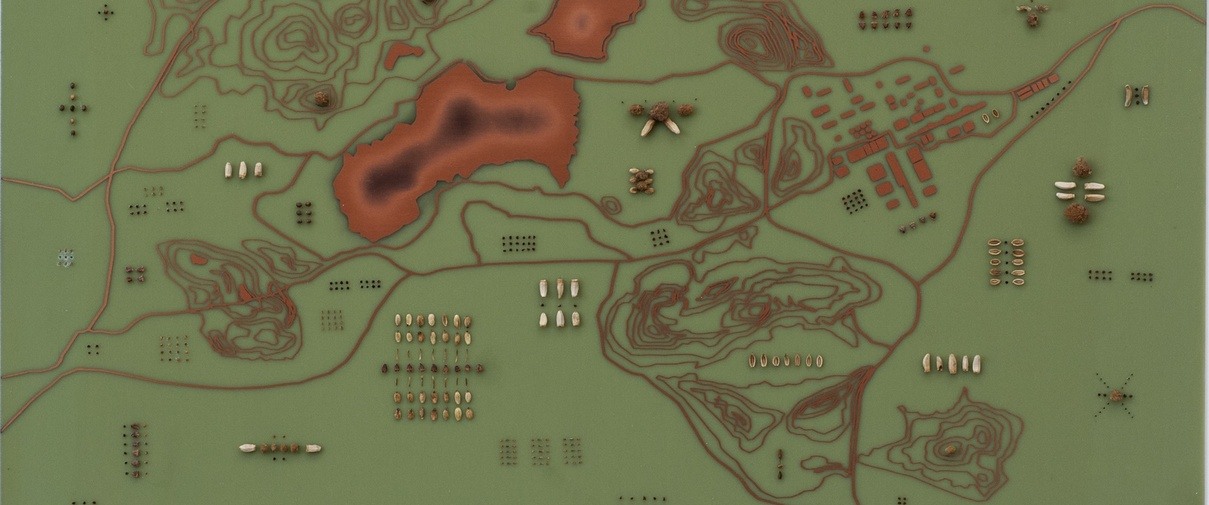The Fries Museum is hosting the contemporary art exhibition Seeds of Memory. In this large group exhibition, artists use traces of the past to tell stories. They depict memories and histories that may have taken place or have been invented, restructuring facts into a new story. The stories unfold in imaginative works in which landscapes, animals, materials and objects are always the starting points: from the artificial division of the animal kingdom to an invented city, and from the long history of a noble Frisian estate to ancient traces in the landscape. With work by Noor Abuarafeh (Palestine, 1986), Mercedes Azpilicueta (Argentina, 1981), Maarten Vanden Eynde (Belgium, 1977), Saskia Noor van Imhoff (Canada/Netherlands, 1982), Bert Scholten (Netherlands, 1988) and Rinus Van de Velde (Belgium, 1983).
RebelseLusthof_V02.jpg?width=1210&height=505&mode=crop&converttowebp=1)
Noor Abuarafeh’s video installation Am I the Ageless Object at the Museum? (2018) interweaves images from zoos in Palestine, Switzerland and Egypt with images of stuffed animals and mounted insects from natural history museums. Offering different perspectives, a voice-over recounts childhood memories of constellations, the evolution of hippos, and the mythical symbolism of whales. Abuarafeh assembled a collection of objects for her installation at the Fries Museum, including stuffed animals from the collection of the Nature Museum Fryslân in Leeuwarden.

Bert Scholten recounts the tradition and history of biscuit moulds in two new videos. A gift of biscuits was formerly a way to convey symbolic messages. The biscuit moulds stem from animal sacrifices, a custom that changed into the making of figurative breads and, eventually, the speculaas biscuits that we enjoy today.
Maarten Vanden Eynde arranged seeds in the shape of the map of the Congolese town of Fungurume, which is surrounded by copper mines, on a circuit board. The work serves as an archive of the local flora and fauna. The circuit board maps rare plant species, which can be used to restore biodiversity around Fungurume once mining activities in that area have ceased.

Saskia Noor van Imhoff is interested in how collections select and classify knowledge. For this exhibition, Van Imhoff developed a room-filling installation based on ongoing research. The installation is rooted in Van Imhoff’s own life: a nineteenth-century farmhouse, its land, and her studio in Gaasterland. Among other things, she examined the growth patterns of the farm’s wooden trusses and traced their place of origin, making them an example of how materials can be repositories of memories.
In Deep in the jungle of our fiction (2016), Rinus van de Velde exhibits a scene inspired by the story of a geographer, a character in the satirical novel ‘Donogoo Tonka’ by Jules Romains (1885-1972). The artist weaved a new character into this existing story. This work challenges the status of scientific knowledge and the notion of cause and effect throughout history.
Finally, De Rebelse Lusthof (2022), a work by Mercedes Azpilicueta, will be presented in the main hall. This monumental tapestry depicts scenes of a garden with huge fruits. The garden contains various objects and figures related to the history of Oranjewoud estate in Friesland, which over the years has been home to workers, poets, rebels and the royal family. This recent acquisition, which Arcadia commissioned from Azpilicueta for the exhibition Paradys, inspired her to create a new installation of objects and costumes especially for this exhibition. This work is on view for the first time.
RebelseLusthof_V02.jpg?width=1210&height=505&mode=crop&converttowebp=1)
Katja Novitskova: Model Earth
The first solo museum exhibition by Katja Novitskova (Estonia, 1984) can also be seen in the Fries Museum. Her work revolves around the relationship between ecology and technology, between the natural and digital worlds. In particular, Novitskova is fascinated by the appropriation and depiction of the landscape and the organisms that are part of it. She sees the human penchant for (making) images as an expression of the relentless expansionism of the human species. Katya Novitskova: Model Earth will be on view until 3 September.
Interactive image
You can ‘scroll’ through this interactive image. Tip: make the image fullscreen and turn on your sound to get the best experience.


